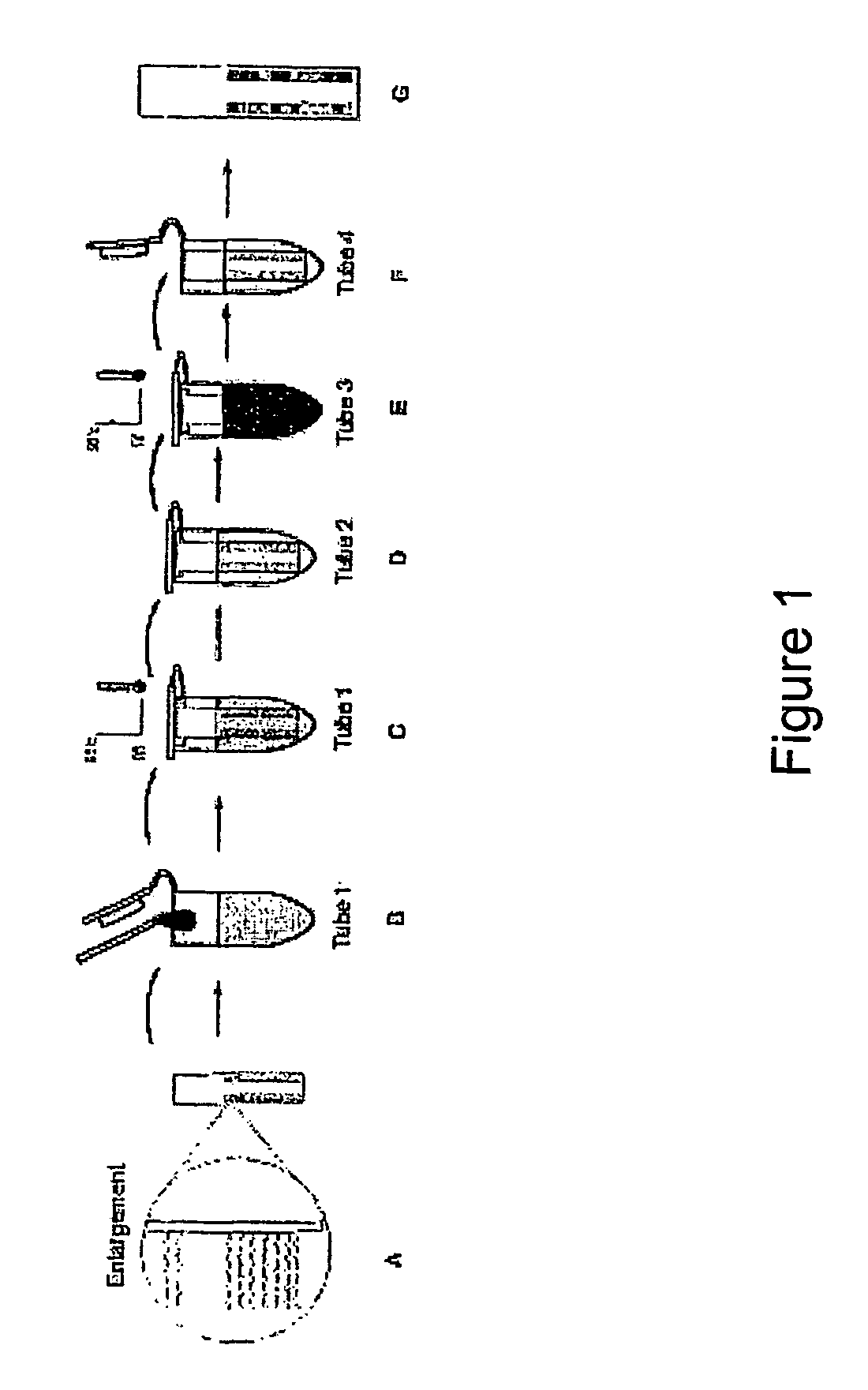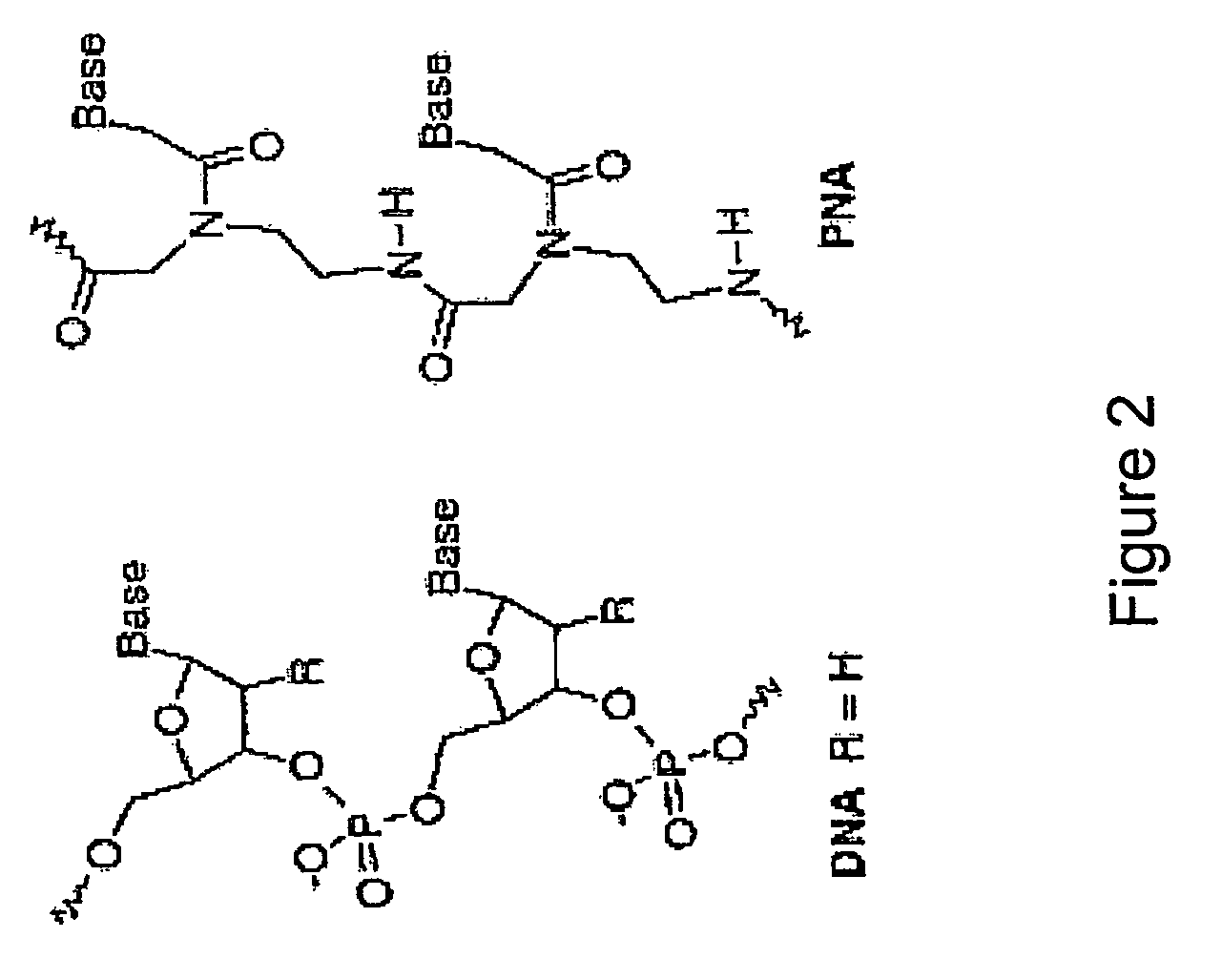System for detecting polynucleotides
a polynucleotide and detection system technology, applied in the field of nucleic acid-based diagnostics, can solve the problems of requiring skilled personnel and specialized equipment, and achieve the effect of reducing the rate of change in the optical property and increasing the optical property
- Summary
- Abstract
- Description
- Claims
- Application Information
AI Technical Summary
Benefits of technology
Problems solved by technology
Method used
Image
Examples
example 1
Liquid-Based Assay System for Detection of PNA Polynucleotide Binding
[0351]The formation of a PNA / polynucleotide complex resulted in a color change of the indicator dye. Cauliflower mosaic virus 35S promoter DNA was used as the specific target polynucleotide. The dye was 3,3′-diethylthiacarbocyanine (Sigma, Milwaukee).
[0352]In a test tube, 15 μM PNA molecules complementary to cauliflower mosaic virus 35S promoter (35SPNA) was added to 5 μM 35S promoter DNA (35SDNA). The PNA sequence was CCCACCCACGAGG-LYS [SEQ ID NO:11]. 150 μM dye in 5 mM phosphate buffer, pH 7.5, was added. The 35SPNA, and dye, are present in excess in the system.
[0353]The color change indicated the presence of the polynucleotide.
[0354]The liquid based system was tested using 1 μl of 2.5 mM dye diluted in a 50 μl total volume of 5 mM PO4 reaction buffer. The system and methods were tested and successful in the pH range of 4-10, however the system performed better in systems above the pH of 5. At time zero reactions...
example 2
Determination of the Effect of PNA Molecules on PCR Reactions
[0358]This Example shows the effects of various PNA molecules on PCR reactions. The PCR components were as follows:
[0359]
FinalComponentVolumeConcentrationWater38μLN / AUpstream primer, 50 μM0.5μL0.5μMDownstream primer, 50 μM0.5μL0.5μMMgCl2, 25 mM3μL1.5mM10× Reaction Buffer (Promega)5μL1XPCR Nucleotide Mix (Promega), 10 mM each1μL800μMdNTPTaq DNA Polymerase in Storage Buffer B0.5μL0.05U / μL(Promega), 5 U / μLBSA0.5μL10mg / mL
[0360]The primer sequences were as follows:
[0361]
PrimerPrimer SequenceOI 175′GCTCCTACAAATGCCATCA[SEQ:12)OI 185′GATAGTGGGATTGTGCGTCA[SEQ:13)PNA5′CCCACCCACGAGGAACATC[SEQ: 14)
Thermal cycler program (MJ Research PTC-200)
[0362]
95° for 1 minute42 cycles of:94° for 10 seconds53° for 10 seconds72° for 20 secondsHold at 4°
[0363]The following samples were analyzed by PCR to determine if PNA molecules inhibit PCR reactions;
[0364]1. 1 μL Bt / RR corn DNA (Bt / RR corn has been genetically modified))
[0365]2. 1 μl Bt / RR corn DN...
example 3
[0378]The time course of light stimulated change in an optical property of 3,3′-diethylthiacarbocyanine iodide for different concentrations of DNA molecule was determined for a specific target polynucleotide sequence, and PNA sequence.
[0379]The target polynucleotide was 5′ CTACGGGAGGCAGCAGTG 3′ [SEQ ID NO:2] and complementary the PNA molecule was CACTGCTGCCTCCCCGTAG-Lys [SEQ ID NO:1]. The target polynucleotide concentrations were those that are listed in the legend of FIG. 5. The PNA concentration was 14.4 pmole / reaction. The dye concentration was 6 nmole / reaction.
[0380]FIG. 5 depicts the time course of 3,3′-diethylthiacarbocyanine iodide dye emission after exposure to light stimulus for different concentrations of DNA. Assay sensitivity with varying test DNA concentration using mixed wavelength light source to stimulate the change. Varying concentrations of polynucleotide (in this case, DNA) are depicted in the Figure legend. Legend represents the final DNA amount in each reaction....
PUM
| Property | Measurement | Unit |
|---|---|---|
| temperature | aaaaa | aaaaa |
| ionic strength | aaaaa | aaaaa |
| ionic strength | aaaaa | aaaaa |
Abstract
Description
Claims
Application Information
 Login to View More
Login to View More - R&D
- Intellectual Property
- Life Sciences
- Materials
- Tech Scout
- Unparalleled Data Quality
- Higher Quality Content
- 60% Fewer Hallucinations
Browse by: Latest US Patents, China's latest patents, Technical Efficacy Thesaurus, Application Domain, Technology Topic, Popular Technical Reports.
© 2025 PatSnap. All rights reserved.Legal|Privacy policy|Modern Slavery Act Transparency Statement|Sitemap|About US| Contact US: help@patsnap.com



